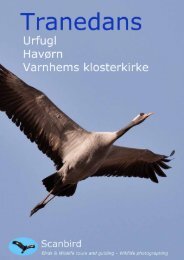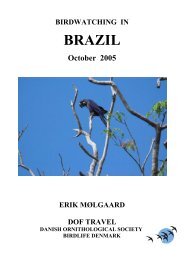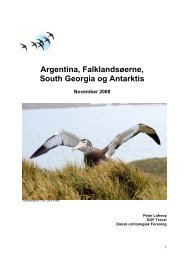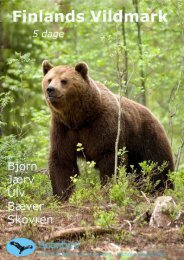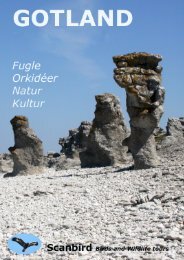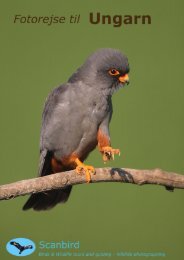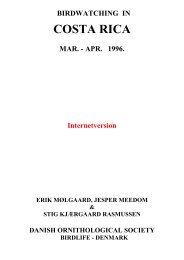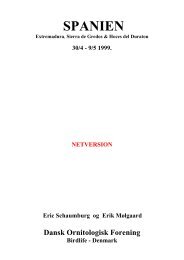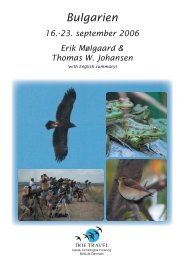Birding Southern Sweden (large PDF file (5 MB) - Tåkerns Fältstation
Birding Southern Sweden (large PDF file (5 MB) - Tåkerns Fältstation
Birding Southern Sweden (large PDF file (5 MB) - Tåkerns Fältstation
Create successful ePaper yourself
Turn your PDF publications into a flip-book with our unique Google optimized e-Paper software.
BRUNO SUNDIN<br />
White-tailed Eagle.<br />
Public Access in <strong>Sweden</strong><br />
In <strong>Sweden</strong>, the Right of Public Access allows you to roam<br />
about freely or to go camping in the countryside. You are<br />
entitled to enjoy the fragrance of the flowercovered meadows,<br />
the singing birds and the peaceful silence of the deep<br />
forest. But please don´t disturb and don´t destroy.<br />
Needless to say, you are not permitted to take any species<br />
of bird’s eggs. Avoid disturbing nests and young animals.<br />
If you keep the following rules in mind you will be sure<br />
of keeping on the right side of Swedish laws and customs.<br />
Respect peoples privacy!<br />
You are perfectly entitled to walk, jog, cycle, ride or ski across<br />
other people’s land – provided you do not cause any damage<br />
to crops, forest plantations or fences. But you are not<br />
entitled to cross or stay on a private plot without permission<br />
– that would be a violation of privacy.<br />
The plot, which is not always hedged or fenced in, is the<br />
area closest to a dwelling house. The people who live there are<br />
entitled to do so in peace. This, after all, is their private area.<br />
Camping<br />
You are allowed to pitch your tent for a day or two on land<br />
which is not used for farming, and which is not close to a<br />
dwelling. The closer to houses you wish to camp, the more<br />
likely you are to cause a disturbance, and the greater the<br />
need to ask the landowner for permission. How long you<br />
can keep your tent pitched in one and the same place depends<br />
on the circumstances.<br />
Enjoy yourselves in the Swedish countryside!<br />
WISP<br />
Wetlands in Spatial Planning<br />
is an EU founded project within the Interreg IIC, North<br />
Sea Region Programme. One of the project´s objectives is<br />
to stimulate sustainable ecotourism as means of promoting<br />
wetlands as a natural resource, an educational asset and a<br />
local source of income and employment. The project focuses<br />
on a number of wetlands which have a rich bird life.<br />
Interconnected wetlands bordering the North Sea are of<br />
crucial importance to a <strong>large</strong> number of bird species. Being<br />
part of the North-East Atlantic Flyway, they are used by<br />
vast numbers of waders and waterfowl breeding in the Arctic<br />
and wintering in Europe or Africa. En route, the birds<br />
are in need of areas for resting and feeding to build up energy<br />
for further travel.<br />
Sustainable development of these wetlands might be the key<br />
to their continued survival and importance, as the majority<br />
are located in densely populated areas and are under several<br />
forms of pressure. The development of locally founded ecotourism<br />
is a way to increase society´s consciousness as a whole<br />
to the values of these wetlands, aiming to aid conserving them<br />
for future generations as well. By allowing a certain amount<br />
of carefully planned activities, both the birds and their habitat<br />
will benefit from increased interest and awareness.<br />
INTERREG IIC<br />
North Sea Region<br />
Project<br />
part-financed by<br />
the European Union<br />
24



